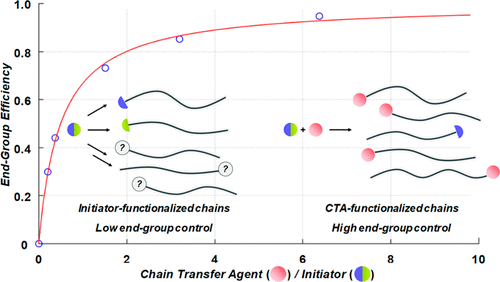当前位置:
X-MOL 学术
›
ACS Appl. Polym. Mater.
›
论文详情
Our official English website, www.x-mol.net, welcomes your
feedback! (Note: you will need to create a separate account there.)
End-Group Control in the Radical Polymerization of Methyl Methacrylate with tert-Butyl Peroxypivalate Initiator in the Presence of Thiol Chain Transfer Agents
ACS Applied Polymer Materials ( IF 4.4 ) Pub Date : 2020-08-13 , DOI: 10.1021/acsapm.0c00598 Wesley Sattler 1 , Matthew C. D. Carter 1 , Nicholas J. Irick 1 , Jim DeFelippis 1 , Ralph C. Even 1
ACS Applied Polymer Materials ( IF 4.4 ) Pub Date : 2020-08-13 , DOI: 10.1021/acsapm.0c00598 Wesley Sattler 1 , Matthew C. D. Carter 1 , Nicholas J. Irick 1 , Jim DeFelippis 1 , Ralph C. Even 1
Affiliation

|
The radical polymerization of methyl methacrylate (MMA) by the thermal initiator tert-butyl peroxypivalate (tBPPiv) and in the presence of various thiol-containing chain transfer agents (CTAs) has been studied to quantitatively determine the chemical selectivity and fate of initiator radicals. Deuterated MMA-d5 was used to follow polymerization reactions by 1D and 2D NMR spectroscopy and to determine the identity and quantity of small molecule byproducts, together with the distribution of polymer end-groups. These data have resulted in a detailed understanding of initiator decay pathways, radical selectivity, and of key importance to the design of well-defined polymers for commercial applications, the efficiency of so-called end-group functionalization. In the presence of a thiol-containing small molecule, chain transfer to CTA leads predominantly to initiation by the resulting thiyl radical; however, direct initiation by initiator radicals and a variety of other reactions reduce the total number of CTA-functionalized chain-ends. The approach reported here gives fundamental insights into the fates of radicals in the polymerization of a model methacrylate, increased control over end-groups, and can be extended to a range of commercially relevant polymer compositions. Moreover, these results provide a quantitative framework that can potentially open the door to the design of end-functional polymers by industrially relevant methods, avoiding the need for more time-consuming and complex reversible-deactivation radical polymerization (RDRP) techniques.
中文翻译:

巯基链转移剂存在下甲基丙烯酸甲酯与过氧新戊酸叔丁酯引发剂自由基聚合的端基控制
已经研究了通过热引发剂过氧新戊酸叔丁基酯(tBPPiv)和存在各种含硫醇的链转移剂(CTA)的条件下甲基丙烯酸甲酯(MMA)的自由基聚合反应,以定量确定引发剂自由基的化学选择性和命运。氘代MMA- d 5用1D和2D NMR光谱追踪聚合反应,并确定小分子副产物的身份和数量,以及聚合物端基的分布。这些数据使人们对引发剂的衰变途径,自由基的选择性以及对用于商业应用的定义明确的聚合物的设计,所谓的端基官能化的效率至关重要。在含硫醇的小分子存在下,链转移到CTA的过程主要是由所得的巯基引发。但是,由引发剂自由基直接引发和各种其他反应会减少CTA官能化链端的总数。本文报道的方法对甲基丙烯酸甲酯的聚合反应中自由基的命运,对端基的控制增加,以及可以扩展到与商业相关的聚合物组合物的范围提供了基本见识。而且,这些结果提供了定量框架,该框架可以通过工业上相关的方法潜在地为最终功能聚合物的设计打开大门,从而避免了对更耗时和复杂的可逆失活自由基聚合(RDRP)技术的需求。
更新日期:2020-09-11
中文翻译:

巯基链转移剂存在下甲基丙烯酸甲酯与过氧新戊酸叔丁酯引发剂自由基聚合的端基控制
已经研究了通过热引发剂过氧新戊酸叔丁基酯(tBPPiv)和存在各种含硫醇的链转移剂(CTA)的条件下甲基丙烯酸甲酯(MMA)的自由基聚合反应,以定量确定引发剂自由基的化学选择性和命运。氘代MMA- d 5用1D和2D NMR光谱追踪聚合反应,并确定小分子副产物的身份和数量,以及聚合物端基的分布。这些数据使人们对引发剂的衰变途径,自由基的选择性以及对用于商业应用的定义明确的聚合物的设计,所谓的端基官能化的效率至关重要。在含硫醇的小分子存在下,链转移到CTA的过程主要是由所得的巯基引发。但是,由引发剂自由基直接引发和各种其他反应会减少CTA官能化链端的总数。本文报道的方法对甲基丙烯酸甲酯的聚合反应中自由基的命运,对端基的控制增加,以及可以扩展到与商业相关的聚合物组合物的范围提供了基本见识。而且,这些结果提供了定量框架,该框架可以通过工业上相关的方法潜在地为最终功能聚合物的设计打开大门,从而避免了对更耗时和复杂的可逆失活自由基聚合(RDRP)技术的需求。


















































 京公网安备 11010802027423号
京公网安备 11010802027423号